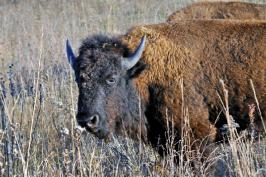 When David Crites walked out of his apartment last month, he was greeted by a line of six or so bison standing shoulder to shoulder in the front yard. He sidled over to his truck, staring at the huge animals, slipped into the front seat, then closed the door and turned on the ignition. As the pickup slowly made its way down the driveway, the bison lumbered alongside.
When David Crites walked out of his apartment last month, he was greeted by a line of six or so bison standing shoulder to shoulder in the front yard. He sidled over to his truck, staring at the huge animals, slipped into the front seat, then closed the door and turned on the ignition. As the pickup slowly made its way down the driveway, the bison lumbered alongside.
Despite the project’s success, the land will never be what it was 200 years ago. The bison each have an identification chip embedded in them, and seven of them wear GPS collars. They’ll never be able to roam wherever they want, and people will always have to manage fires on the land, raising the question of what is truly wild.
“It was like I was in Yellowstone,” Crites says. But he wasn’t. His temporary job (which includes housing) is to remove trees and install fences in the Nachusa Grasslands of north-central Illinois—where wild bison recently set hooves down for the first time in almost 200 years.
Photo credit: Rick Hansen / U.S. Fish and Wildlife Service